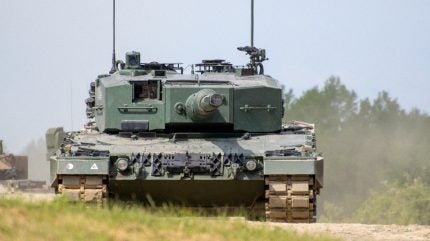
The German government has orchesterated a deal with the Czech Ministry of Defence to furnish it with 14 Leopard 2A4 main battle tanks (MBTs) and a single ARV 3 Buffalo armoured recovery vehicle in exchange for equipment bound for Ukraine.
At the centre of the deal, Rheinmetall, a German automotive and arms manufacturer, will supply the platforms to Prague. The first Leopard is set to arrive by the end of this year while the rest of the tanks are to be delivered until the end of 2025, followed shortly by the Buffalo at the start of 2026.
Signed at the end of July 2024 and revealed in a company statement for the first time on 12 August, the value of the agreement lies in the low three-digit million euro range.
With no time to spare, Rheinmetall confirmed that work on the vehicles has already begun.
Although the Leopard 2 is a formidable platform designed and built by KNDS, Rheinmetall serves as a close industrial partner with its 120-millimetre smoothbore gun, ammunition and fire control systems.
Currently, the Czech Army operate 14 Leopard 2A4 units, and by the end of the MBT delivery, this will amount to 28 MBTs.
The vehicles being made available to the Czech Army are upgraded MBTs formerly used by undisclosed countries. Likewise, the Buffalo will be mounted atop an enhanced Leopard 2 chassis.
Meanwhile, Ukraine is set to receive “Soviet-era heavy equipment.” While the specific systems have not been disclosed, the Czech Republic has a wide collection of systems left over from the Cold War, from MT-55A engineering vehicles acquired in the early 1970s to the most widely produced tank in history, the T-55. Though, the exact number of these platforms is not known, says GlobalData intelligence.
A systematic solution to procurement
This swap scheme, which Germany calls its ‘Ringtausch’ (‘Ring swap’) initiative, is not the first of its kind. In fact, Germany has previously engaged the Czechs in such a deal – the first of them began in October 2022.
Designed with mutual assurance in mind, the swap scheme aimed to modernise Europe’s collective inventories with more sophisticated weaponry and vehicles in a new age of warfare after 20 years of neglect, while also providing such systems for immediate use in Ukraine.
The first scheme followed the German Chancellor Olaf Scholz’s ‘Zeitenwende’ speech in which he marked an historical turning point in German defence policy. A year after the speech, the Institute for International Strategic Studies judged that this had yet to be realised.
“The [German] Federal Ministry of Defence does not yet seem to have fully incorporated the lessons learned from Ukraine in a systematic way to guide future military strategy, operational planning or procurement.”
Since then, Europe is beginning to wrestle with the problem at a continental level. Through its inaugural defence industrial plan laid out in April 2024, and the €1.5bn ($1.63bn) to implement their objectives, the European Union is set to pursue longer-term plan for its defence industrial renewal.





